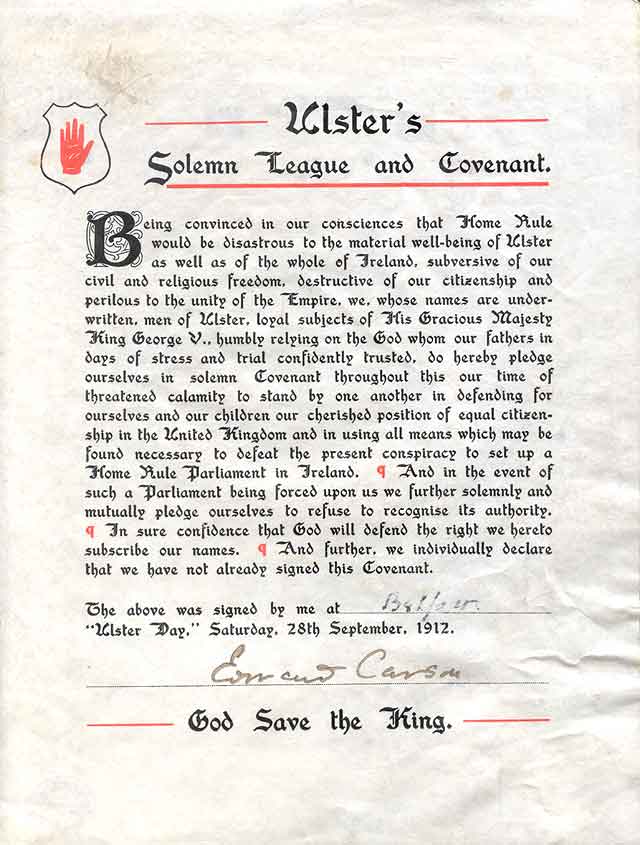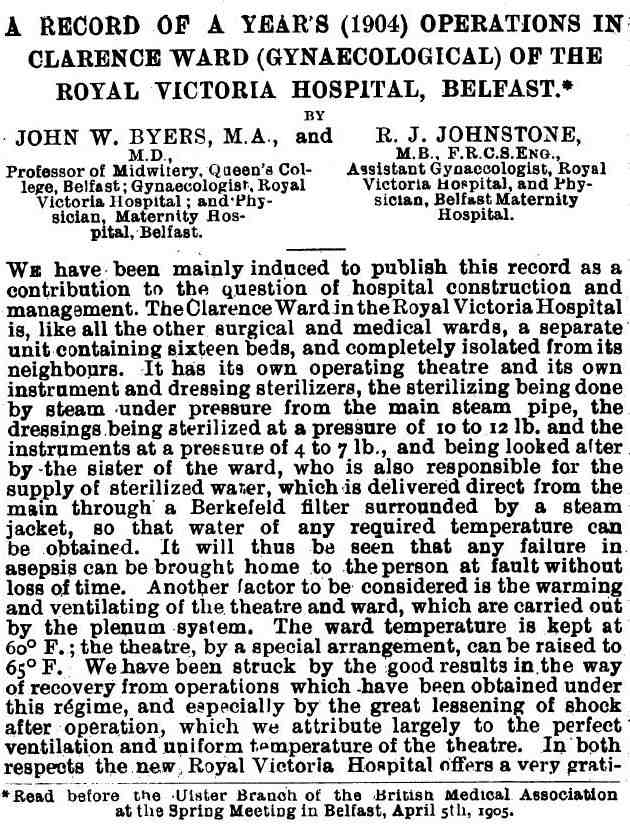On this page:
Ulster Covenant
On 28 September 1912, 237,368 men signed the Ulster Covenant, and 234,046 women signed the parallel Women's Declaration.These were Unionists opposed to the Government's plan to introduce Home Rule for Ireland.The Public Record Office of Northern Ireland (PRONI) has digitised the original signed declarations and made them available on its Ulster Covenant website - well worth exploring.
The PDF below lists all the Byers signatories (with addresses), many from Cavan, including my grandmother Letitia Alice Byers.

Sir John Byers (1853-1920)
Sir John William Byers was the son of Margaret Byers, the pioneer of women's education.
He graduated from Queen's University (BA 1874, MA 1875). He became a distinguished Professor of Midwifery and Diseases in Women at Queen’s College (Queen's University from 1908). He married Fanny Reid on 10 September 1902 and was knighted in 1906. They lived at Waterfoot House, Newcastle, Co. Down, and Dreenagh House, Belfast, and had three sons.A dinner was held in Sir John's honour at the Royal Victoria Hospital, Belfast, on 20 January 1920, reported in the British Medical Journal, 31 January 1920 (Sir John died later that year on 20 September 1920):
After the toast of the King, the chairman [Professor James Lindsay] proposed the health of Sir John Byers, and made the presentation on behalf of the medical staff. In doing so he referred in terms of high praise to Sir John's long connection with the hospital, his skill as a surgeon, his powers as a clinical teacher, and the administrative ability he showed as a member of the board of management.
After
the toast of the King, the chairman [Professor James Lindsay] proposed
the health of Sir John Byers, and made the presentation on behalf of the
medical staff. In doing so he referred in terms of high praise to Sir
John's long connection with the hospital, his skill as a surgeon, his
powers as a clinical teacher, and the administrative ability he showed
as a member of the board of management.
He mentioned also the keen interest Sir John had always taken in the public health of the city, especially with regard to tuberculosis and infant welfare. Sir John was also an authority on the folk-lore, phraseology, and antiquities of the province.
Professor Sinclair, C.B., then spoke in warm terms of Sir John Byers, as his lifelong friend, and referred to his early work in the Queen Street Hospital for Sick Children.
Dr. Walton Browne, D.L., a member of the consulting staff, and Mr. B. J. Johnstone, F.H.GVS., also joined in the expressions of good-will; the latter said he had worked with Sir John for many years as his assistant, and spoke of his great power as a lecturer, and his constant desire to forward the interests of the younger medical men.
He mentioned also the keen interest Sir John had always taken in the public health of the city, especially with regard to tuberculosis and infant welfare. Sir John was also an authority on the folk-lore, phraseology, and antiquities of the province.
Professor Sinclair, C.B., then spoke in warm terms of Sir John Byers, as his lifelong friend, and referred to his early work in the Queen Street Hospital for Sick Children.
Dr. Walton Browne, D.L., a member of the consulting staff, and Mr. B. J. Johnstone, F.H.GVS., also joined in the expressions of good-will; the latter said he had worked with Sir John for many years as his assistant, and spoke of his great power as a lecturer, and his constant desire to forward the interests of the younger medical men.

From the British Medical Journal, 6 May 1905
His obituary a few months later (British Medical Journal, 2 October 1920) added:
Sir John Byers had many and varied interests; amongst these he was a diligent student of the folklore and dialect of Ulster, and was busily engaged during the last few years in the preparation of a book on the subject; he was one of the referees for the province in connection with the Oxford Dialect Dictionary; and nothing pleased him more than to get into conversation with some countryman from an out-of-the-way district and learn his feelings, beliefs, and speech.
In 1894 a number of his friends presented him with his portrait in oils, together with a replica for his wife; the former was hung in the Examination Hall of the College.
He was always in the forefront in all matters of public health, and showed himself a clear and convincing speaker and a keen debater; one always knew on which side he was in a controversy, and he was a loyal and staunch friend; the students will miss a stimulating influence in the school, and the profession a protagonist who stood for its welfare and high interests.
The amount of work he got through was enormous, and the range of his contributions and his activities has become, one may say, proverbial. Although he could not stand shuffling or underhand meanness, aud exposed them ruthlessly, yet he had a kind heart and was ever ready to help the young medical man in his struggles; his last act of paying tribute to the worth of a dead colleague was a fit ending to his labours.
More details of Sir John’s family are given at thePeerage website.
Sir John Byers had many and varied interests; amongst these he was a diligent student of the folklore and dialect of Ulster, and was busily engaged during the last few years in the preparation of a book on the subject; he was one of the referees for the province in connection with the Oxford Dialect Dictionary; and nothing pleased him more than to get into conversation with some countryman from an out-of-the-way district and learn his feelings, beliefs, and speech.
In 1894 a number of his friends presented him with his portrait in oils, together with a replica for his wife; the former was hung in the Examination Hall of the College.
He was always in the forefront in all matters of public health, and showed himself a clear and convincing speaker and a keen debater; one always knew on which side he was in a controversy, and he was a loyal and staunch friend; the students will miss a stimulating influence in the school, and the profession a protagonist who stood for its welfare and high interests.
The amount of work he got through was enormous, and the range of his contributions and his activities has become, one may say, proverbial. Although he could not stand shuffling or underhand meanness, aud exposed them ruthlessly, yet he had a kind heart and was ever ready to help the young medical man in his struggles; his last act of paying tribute to the worth of a dead colleague was a fit ending to his labours.
More details of Sir John’s family are given at thePeerage website.
Byers emigration to the USA, 20th century
The PDF contains a short one-page list which needs more research to fill it out.

|
20th Cent Shipping Records.pdf Size : 82.461 Kb Type : pdf |